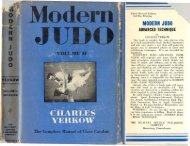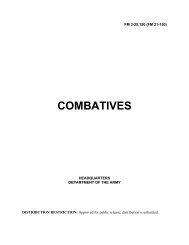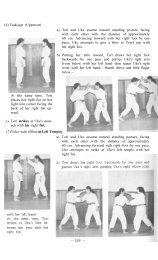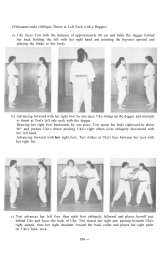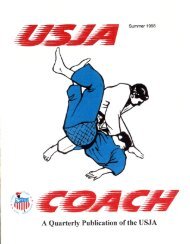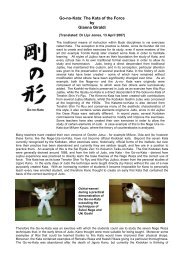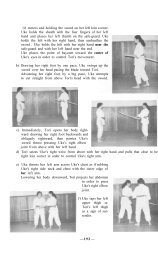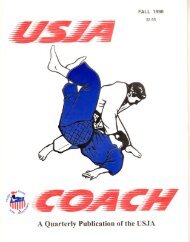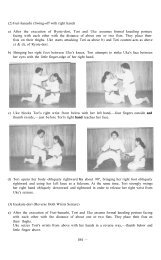What is Kata?
What is Kata?
What is Kata?
Create successful ePaper yourself
Turn your PDF publications into a flip-book with our unique Google optimized e-Paper software.
<strong>What</strong> <strong>is</strong> <strong>Kata</strong>?byJohn Corn<strong>is</strong>hSyd Hoare once asked me “<strong>What</strong> <strong>is</strong> <strong>Kata</strong>?” Coming from him I knew it was not a simple question,so I answered “<strong>Kata</strong> <strong>is</strong> anything that <strong>is</strong> not the true thing”. There was no need to elaborate, and as Iwas still wet from the shower, I was glad of th<strong>is</strong>. For those I don’t know, and who don’t know me, Iwill try to explain what I meant.I will call what most people know as <strong>Kata</strong> in Judo, that <strong>is</strong>, a set of differing techniques, “L<strong>is</strong>ted<strong>Kata</strong>”.To me Uchi-komi (Repetition Practice) <strong>is</strong> <strong>Kata</strong>. Uchi-komi, usually done with Uke standing still in acertain stance, the thrower, if that <strong>is</strong> what he <strong>is</strong> doing and not training at <strong>Kata</strong>me-waza, can move insay nine times just picking the partner up to the point where h<strong>is</strong> feet just start to leave the mat, andwhere very little more effort would throw the partner. Shall we call th<strong>is</strong> point complete Kuzushi, orthe point of Kake? Then on the tenth time the partner <strong>is</strong> thrown. I believe th<strong>is</strong> Uchi-komi shouldalso be done with the partners taking one or two steps before the technique <strong>is</strong> performed. To go onfrom th<strong>is</strong> system it could be done on the move in a modified form of Ran-dori, but where the partnerstake turns at the technique.So far I hope you will agree th<strong>is</strong> <strong>is</strong> <strong>Kata</strong>, as there <strong>is</strong> complete cooperation.Ran-dori (Free Practice) <strong>is</strong> a form of <strong>Kata</strong>. In fact Prof. Kano called the Nage-no-kata and the<strong>Kata</strong>me-no-kata the “Ran-dori-no-kata” so he thought there was a connection before I did. It couldbe argued that the two <strong>Kata</strong> were to be studied before Ran-dori was attempted. Many Martial Artsschools do not allow “Free Practice” under certain grades, and controlled training, like th<strong>is</strong>, that keeptrainees safe were of course part of Judo.We can’t say all the techniques in these two <strong>Kata</strong> are now used in Ran-dori. Ashi-kan-setsu-wazawas allowed in early Judo, but as there were some injuries to legs, they were banned in Shi-ai(Contest) and so also in Ran-dori.When I started Judo, in Britain there was a restriction in place on Sute-mi throws for people belowIkkyu (First-kyu-grade). As a nil grade, my first injury came about by someone trying a Sute-miwazaon me that he had seen in a demonstration. I still have trouble with that injury, and agree withcaution when it comes to what techniques are suitable for what grades.Prof. Kano also called <strong>Kata</strong> the Grammar of Judo and Ran-dori the composition.Ran-dori <strong>is</strong> m<strong>is</strong>used when it <strong>is</strong> used as Shi-ai (Match, contest). The Ran-dori training sessions shouldbe used to hone up certain points of our Tokui-waza (favourite technique), to try out our Tokui-wazawith other techniques in differing combinations. We should also try out techniques we are weak at,especially if the partner <strong>is</strong> below out standard. A battleship should not use its big guns on a f<strong>is</strong>hingsmack.While we are doing these things we will be countered, if the partner <strong>is</strong> working on Kaeshi-waza. Wewill also leave ourselves open, to the partners techniques, especially if he <strong>is</strong> using h<strong>is</strong> Tokui-waza.1
As we are competing, not against the partner, and he should be thought of as a partner not anopponent, we should be competing if anything against our own self, we can lose in Ran-dori only bywasting our own time and effort by a bad attitude.Like in the Olympics, we in Judo should always be in pursuance of excellence.To go from one extreme of Ran-dori, that of fighting all out, to the other extreme, of being overcooperative, even jumping for the partner must be avoided, if Ran-dori <strong>is</strong> to be a worthwhile trainingmethod.Th<strong>is</strong> kind of Ran-dori, which must be carried out correctly, I see as <strong>Kata</strong>. Even training with theL<strong>is</strong>ted <strong>Kata</strong>, there are many pit falls, but they are the same ones that we have to avoid in all othertraining in Judo.If the partners are equal in skill and have a little competitive spirit, they could fight for the firstippon, then for the rest of the training session, get down to the real learning training, that of gettingmore than the partner out of the session.In some Traditional Martial Arts they have a form of training like Ran-dori, and it can be called Ji-Yu-Kei-Ko, or whatever word the school uses.Shi-ai (Match) I think of as <strong>Kata</strong> as a step in training for higher level Shi-ai (the Olympic Gold?).To give another example of my idea why Shi-ai could be thought of as <strong>Kata</strong>. Many students startJudo with the aim of learning Self-defence. Coaches please note. Any contest th<strong>is</strong> kind of studenthas will certainly be <strong>Kata</strong>.With the strict rules of Shi-ai, most of the most important parts of Self-defence training, those againstblows, kicks and weapons, for the life or death struggle the student had in mind, will be m<strong>is</strong>sing. Hewill also be restricted to using techniques, and even grips, allowable in Shi-ai.Apart from the boundaries put on techniques in contest, the scores used in contest can lead tom<strong>is</strong>understanding by the student if he thinks any kind of win <strong>is</strong> acceptable. There <strong>is</strong> no Ko-ka win inSelf-defence, so there should be none in training.At the inception of Judo, contest came in as an important part of training. Later contest was neededto make Judo into an international sport, but it was never thought of as a whole method of Selfdefence.Having said what I think <strong>Kata</strong> <strong>is</strong> it will be seen that I think <strong>Kata</strong> cannot be avoided in Judo, and <strong>Kata</strong><strong>is</strong> where we can see the application of the principle of Ji-ta-kyo-ei.Let me now talk some more on the l<strong>is</strong>ted <strong>Kata</strong>.L<strong>is</strong>ted <strong>Kata</strong> has a bad press in Judo in the West. One reason <strong>is</strong> the difficulty with the translation ofthe word into Engl<strong>is</strong>h, maybe the reason I was asked the question in the first place.Even T.P. Leggett, for h<strong>is</strong> books on <strong>Kata</strong>, calls it “Formal Demonstration”. I have a great respect forhim, and I admit all the words used, form, etc. don’t fill the bill and a long-winded explanation <strong>is</strong> no2
good on the front of a book. The thing <strong>is</strong>, if we think <strong>Kata</strong> <strong>is</strong> either formal or a demonstration oreven both of those things together, we get led down the wrong path.When <strong>Kata</strong> <strong>is</strong> performed as a demonstration of high standard <strong>Kata</strong>, it will be formal, but thedemonstration only takes a few minutes, while the training to get to th<strong>is</strong> stage takes hours and hoursof hard work most of which <strong>is</strong> not formal and never a demonstration. If the training <strong>is</strong> too formal, Ithink the <strong>Kata</strong> will never get to a decent standard.We have another problem with the word “formal”, or <strong>is</strong> it the same problem as with “<strong>Kata</strong>”? Formal,in relationship to <strong>Kata</strong>, to me means all the moves to get into the technique, directions and positionson the mat, even the order of the techniques. The bows can be less formal, a Tachi-rei (StandingBow) at the beginning and end of the whole session <strong>is</strong> sufficient instead of a Za-rei (Kneeling Bow)demanded in some L<strong>is</strong>ted <strong>Kata</strong>.No matter what the session was about, even if I were to go into the Do-jo to sweep it out I wouldcarry out one bow on entry and another when leaving, so I don’t consider th<strong>is</strong> formal, just ordinaryJudo politeness.Each of the L<strong>is</strong>ted <strong>Kata</strong>, have do’s and don’ts that apply in particular to that L<strong>is</strong>ted <strong>Kata</strong> and deservea long study, but let us continue with a general look at what <strong>is</strong> <strong>Kata</strong>.I have already mentioned training with <strong>Kata</strong>, and if only we take a glance at the Eastern Martial arts,we will see that th<strong>is</strong> <strong>is</strong> the true use of <strong>Kata</strong>. The schools all have <strong>Kata</strong> as a main method of training,some have <strong>Kata</strong> as the exclusive training method (see G. Koizumi’s book).People don’t seem to notice that <strong>Kata</strong> <strong>is</strong> also used in the West. Here again maybe because we don’thave a word for it.In the Royal Navy they had a <strong>Kata</strong>, where a field gun <strong>is</strong> supposedly taken into the mountains wherevarious problems had to be overcome. One problem was a small opening where the gun and limberhad to be d<strong>is</strong>mantled and after being passed through the opening put back together again. There wasalso a problem where the gun and limber had to go over an obstacle, and there was even a chasm thathad to be crossed. The gun of course had to be fired at the end of each journey, which <strong>is</strong> the wholepoint of taking a gun on a journey.Th<strong>is</strong> training <strong>Kata</strong>, like all good L<strong>is</strong>ted <strong>Kata</strong>, <strong>is</strong> about as near the true thing as one can get withoutputting the trainees at undue r<strong>is</strong>k. In the case of the gun, in the true thing there would of course beproblems like snipers shooting at the team, but even in the armed forces you cannot have th<strong>is</strong> kind ofdanger in training.Judo began as a Martial Art, and to keep th<strong>is</strong> tradition we need the L<strong>is</strong>ted <strong>Kata</strong>. “Tradition” <strong>is</strong>another word we could spend time on, but let us move on and look some more at the irreplaceablepractical use of <strong>Kata</strong>.We must read up on what Kano said to find all the details of what he thought Judo should be, but onething <strong>is</strong> obvious all Judo training must be safe to carry out, if it <strong>is</strong> not safe it <strong>is</strong> not Judo.For the sake of safety some techniques were banned from Shi-ai. Th<strong>is</strong> had an influence on theunwritten rules of Ran-dori.3
Those potentially dangerous techniques, leg locks, wr<strong>is</strong>t locks, spine locks and such like were notbanned entirely, they are now in the L<strong>is</strong>ted <strong>Kata</strong>, where they can be learned by Tori and yet keepUke safe.So Judo <strong>Kata</strong> and Martial Arts <strong>Kata</strong> are used for the same reason, safety in training.A thing that <strong>is</strong> easily overlooked in the L<strong>is</strong>ted <strong>Kata</strong> are the things the attacker, Uke, must learn.In the Kime-no-kata and Go-shin-jutsu, for example, Uke must learn to use a sword, a knife, a stickand a gun.Uke must also learn non weapon techniques such as kicking, poking, punching and hitting in otherways, to name just a few things that help to broaden the, dare I say it, the Judo education that cannotbe learned in Judo sport training.If the Judo education were as broad as it should be, I think we would attract and keep more members.Each of the L<strong>is</strong>ted <strong>Kata</strong> can be looked-on as a study on its own, but a careful look will show us thatthe whole l<strong>is</strong>t has a balance so that each of the L<strong>is</strong>ted <strong>Kata</strong> compliments the other <strong>Kata</strong>.For example we see the attack Ryo-te-tori (Both-hands-held) in Kime-no-kata, Go-shin-jutsu and Juno-kata,and in each <strong>Kata</strong> there <strong>is</strong> a differing response. So, by the practice of these <strong>Kata</strong>, we learnthere <strong>is</strong> more than one way to react to, at least, th<strong>is</strong> attack.We know how much effort we have put in to learn just one throw. For our Tokui-nage-waza we aretraditionally told we need to carry it out in practice a hundred thousand times before we can be saidto have anything like a facility for the throw, (See T.P. Leggett’s article “The Cherry Tree”). Weknow even then how difficult it <strong>is</strong> to pull it off in a competitive situation.Banned in Shi-ai but in the L<strong>is</strong>ted <strong>Kata</strong>, are throws that should be easier to execute, those that aredone with a Kan-setsu-waza (joint-technique). Uke’s balance <strong>is</strong> broken, not only by Tori, but by Uketrying to ease the danger to h<strong>is</strong> joint. Sometimes th<strong>is</strong> kind of throw can be continued into a holdingposition with the Kan-setsu-waza still in place, so <strong>is</strong> very efficient in th<strong>is</strong> way.Also the <strong>Kata</strong>me-waza (control-technique) <strong>is</strong> sometimes fin<strong>is</strong>hed with Uke held in a face downwardsposition, which <strong>is</strong> better in Self-defence.If I can sum up, I think all training, in Judo <strong>is</strong> <strong>Kata</strong>. Judo I think <strong>is</strong> a complete system on its own,and if wholly used <strong>is</strong> a broad enough “Church” to attract and sat<strong>is</strong>fy new members and keep thosealready in Judo with plenty to learn into old age.4






